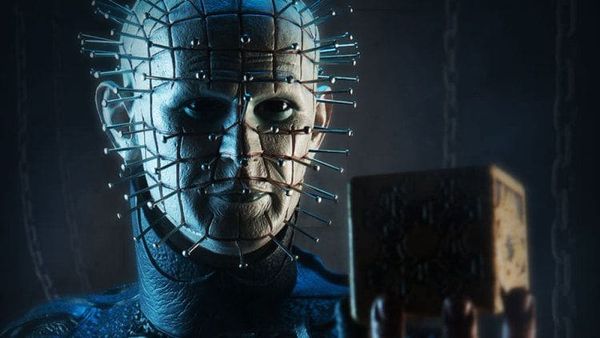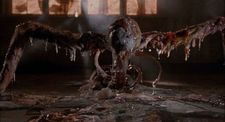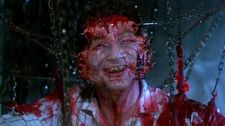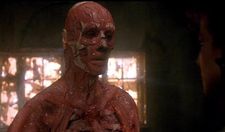 |
| The iconic Pinhead |
Over time, many horror films lose their bite. What is shocking to one generation seems tame to the next, whilst ever-improving special effects technology makes it possible to take fantastic and gory scenarios further and further. There are exceptions, however. In the 30 years since it first came out Hellraiser, which broke many boundaries in its time, has gained a huge cult following. It is a staple of midnight horror marathons and it has just enjoyed an anniversay re-release on the big screen.
This is thanks in part to special effects that broke new ground and still look stunning today. Stuart Conran was still in his teens whem he joined the film's special effects crew. He would go on to have an amazing career, making his mark in films as diverse as The Piano, From Hell, The Hours, Shaun Of The Dead and High-Rise, but he still fondly remembers the Hellraiser experience. He kindly agreed to answer some questions about it.
 |
| The resurrection of Frank |
Jennie Kermode: How did you feel working on a Clive Barker film at the very start of your career?
Stuart Conran: Initially, I was just amazed and grateful to have my foot in the door of a potential career in film. A few months previous to starting on Hellraiser I had read one of the Books Of Blood series. I was aware of Clive's work and the anticipation surrounding it, so going in, it felt like the subject matter was going to be quite unique and very different from anything being made at the time.
JK: Did you have any idea, when you were making it, that Hellraiser would still be this popular 30 years later?
SC: No, I had no idea. I'm still amazed at the enduring nature of it. At the time it was a fairly small production, but the buzz behind it was focused around Hellraiser being Clive's directorial debut, off the back of his written work. But I would never have expected to be still talking about it 30 years later. I'm very proud to have been involved.
JK: As one of the younger members of the team, were you aware of how innovative the effects were when you were working on them?
SC: I had previously worked on a student film, so this was a world away from that experience. I was very aware of the innovation at work and soaked up as much of it as I possibly could. I was introduced to lots of new materials, products and processes I had only read about in Fangoria ... I learnt so much. I got to make my first fiberglass mould, paint foam latex, puppeteer, help apply prosthetics and all kinds of other fun stuff. The birth of Frank sequence, filmed after the main shoot, was a real eye opener and it was great to be involved in working on those effects, where we were creating layered wax pieces to be melted and reverse-filmed.
 |
| The famous Hellraiser flesh-hooks |
JK: How much of the design of the effects were you responsible for?
SC: I wasn't responsible for much of the design at all - I was a trainee, which was mostly assisting work. Later into the shoot I was given free reign with a few small pieces to work on: inserts of hooks going into skin, a huge hook going up Frank's back and other bits and pieces. The cenobite designs were mostly Clive's work, and everything else the work of Bob (Keen) and his crew, made up of a group of young and talented up-coming effects technicians.
JK: What were the most challenging aspects of getting it all to work?
SC: Most challenging aspects on a production are always time and money. Although I was never privy to the money aspect, there were certainly times where extra hours and late nights were spent on the build in preparation of delivering an effect on set. Other aspects were where an effect just didn't work for what was required, a script change or the director changing their initial idea. An instance that comes to mind is Frank after he is resurrected. A fully animatronic skeletal puppet was built, but after a camera test it was decided to go with his very early stage as a prosthetic make-up instead, and the puppet was scrapped. I remember being absolutely gobsmacked that such a thing could happen ... but this happens all the time in the film world!
JK: Looking back, what do you feel are the key reasons why the effects made such a big impression, and why they've aged so well?
SC: I think initially the cenobite designs are very impressive, imbedding themselves in the mind. I believe they have made such an impression because they contrast so much with the odd "real world" feel of the rest of the film, and really grab the imagination. The film is also beautifully shot and edited - which is the ideal way to treat all special effects make-up, like illusions that have to be seen from just the right angle to work properly. Looking back, some of the FX probably looked a bit ropey ... but lighting and editing work wonders!
 |
| Partially reconstructed Frank |
JK: How much did you get to see of what was going on with the rest of the production?
SC: I was exposed to most of what was going on. The shoot was based at a small sound stage in Cricklewood. The production offices were there, editing suites, costume room, make-up rooms etc, so it was all based in one facility. It was a fairly small crew with quite a family feel to it. It never happens nowadays, but at the end of each day we would watch the rushes or dallies, the shoot from the previous day. That was a great way to see how the work was looking and the film in general. As someone new to the film world, it was an incredible experience. I started fairly early into preproduction, when the effects build was in its early stages. I was able to see everything created from their initial designs through to the finished work on set. I feel privileged to have been able to see it all in progress.
JK: What did you learn on Hellraiser that you've gone on to use on other films?
SC: Probably everything. Not only from a practical and technical aspect, but also to do with the world of work in general. I learnt so much from it and still try to put it into practice today; working and communicating with people, people politics, thinking out of the box, adapting to changes. As my first introduction to work and the world of film, it was so profound it has stayed with me all this time!





















